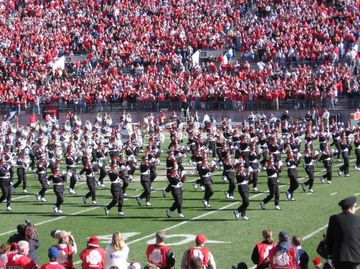 The Ohio State University Marching Band, nicknamed "The Best
Damn Band in the Land," performing it's famous "ramp entry"
into Ohio Stadium at the beginning of a football game.
The Ohio State University Marching Band, nicknamed "The Best
Damn Band in the Land," performing it's famous "ramp entry"
into Ohio Stadium at the beginning of a football game.
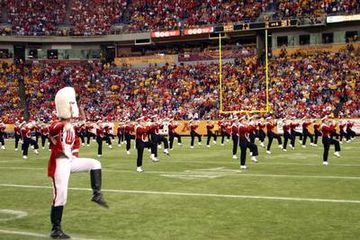 The Wisconsin Band, known for its unique "stop at the top"
high step, performs at the HHH Metrodome during a football
game against arch-rival Minnesota.
The Wisconsin Band, known for its unique "stop at the top"
high step, performs at the HHH Metrodome during a football
game against arch-rival Minnesota.
A marching band is a group of instrumental musicians who generally perform outdoors, and who incorporate movement – usually some type of marching – with their musical performance. Instrumentation typically includes brass, woodwinds, and percussion instruments and the music usually incorporates a strong rhythmic component suitable for marching.
In addition to traditional parade performances, many bands also perform field shows at special events (often American football games) or at marching band competitions. Marching bands are generally categorized by function and by the style of field show (if any) they perform. Increasingly, Marching Bands are performing indoor concerts, in addition to any "Pep Band" duties, that implement many of the songs, traditions, and flair from outside performances.
Contents |
Types of Marching Bands
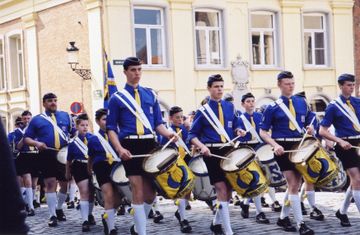 Marching Band - Bruge, Belgium
Marching Band - Bruge, Belgium
Marching bands can be categorized based on primary function, instrumentation, and style.
- Parade bands generally play marches. Instrumentation varies, and can contain anything from bagpipes or fifes and drums all the way to full wind and percussion sections. Many military and veterans' organizations have their own parade bands.
- Show bands (field shows) have the main role of performing at sporting events, usually American football games. They perform a field show before the game and at halftime (and sometimes after the game as well). Show bands typically march in time to the music, and may also participate in parades and competitions. Show bands contain brass and percussion instruments, but may or may not use woodwinds or a percussion pit.
- Carnival Bands are a UK variant of Show bands. Carnival bands typically march in time to the music, and may also participate in parades and competitions. Carnival Bands contain brass and percussion, but may or may not use woodwinds. The main competition body for carnival bands is The Carnival Band Secretaries League (CBSL) [1]. The CBSL Champions 2001 to 2005 are the Derby Midshipmen Band
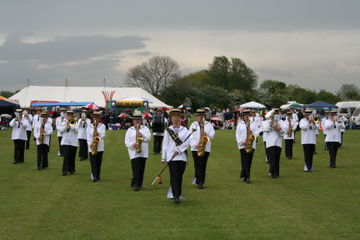 Derby Midshipmen Band - Derby, UK
Derby Midshipmen Band - Derby, UK
- Scramble bands are a variation on show bands. They generally do not march in time with the music, and often incorporate comedic elements into their performances.
- Historically black college and university (HBCU) bands are another variation on show bands that incorporate energetic dance moves into their field shows.
- Drum and bugle corps is a genre of marching ensemble that is distinctly divided into classic and modern corps. Both groups have long, continuous histories and developments separate from marching bands. As the name implies, bugles and drums form the musical background of the corps, but modern competitive drum corps incorporate other brass instruments and orchestral percussion. In the United States, Drum Corps International (DCI) is the governing body for competitive junior drum and bugle corps, while Drum Corps Associates (DCA) is the governing body for competitive all-age (or senior) drum and bugle corps.
- Ancient Fife and Drum Corps
This article will focus primarily on parade and show bands.
History
Marching bands evolved out of military bands. As musicians became less and less important in directing the movement of troops on the battlefield, the bands moved into increasingly ceremonial roles. An intermediate stage which provided some of the instrumentation and music for marching bands was the modern brass band, which also evolved out of the military tradition.
Many military traditions survive in modern marching band. Bands that march in formation will often be ordered to "dress" their "ranks" and "cover [down]" their "files". They may be called to "attention", and given orders like "about face" and "forward march". Uniforms of many marching bands still resemble military uniforms.
Outside of police and military organizations, modern marching band is most commonly associated with American football, and specifically the halftime field show. Many U.S. universities had bands before the twentieth century.
Another innovation that appeared at roughly the same time as the field show and marching in formations was the fight song. University fight songs are often closely associated with the university's band. Some of the more recognizable and popular fight songs, such as the University of Wisconsin's "On Wisconsin," Michigan's "The Victors," Notre Dame's "Victory March," and the United States Naval Academy's "Anchors Aweigh" are widely utilized by high schools across the country.
Other changes in marching band have been:
- adoption of the tradition by secondary schools (high schools, junior high schools, and middle schools)
- the addition of a dance team, cheerleaders (sometimes called poms), and/or baton twirlers
- the addition of colorguard members
Since the inception of Drum Corps International in the 1970s, many marching bands that perform field shows have adopted changes to the activity that parallel developments with modern drum and bugle corps. These bands are said to be corps-style bands. Changes adopted from drum corps include:
- marching style: instead of a traditional high step, drum corps tend to march with a fluid roll step to keep musicians' torsos completely still (see below)
- the adaptation of the color guard, rifle, and sabre units into "auxiliaries", who march with the band and provide visual flair by spinning and tossing flags or mock weapons and using dance in the performance
- moving marching timpani and keyboard percussion into a stationary sideline percussion section (pit), which has since incorporated many different types of percussion instruments
- the addition of vocalists and/or electric instruments (marching bands have as a general rule adopted these aspects before drum corps, for instance the Drum Corps International circuit has only allowed electronic amplification since 2004 and has yet to permit electronic instruments without penalties)
- marching band competitions are judged using criteria similar to the criteria used in drum corps competitions, with emphasis on individual aspects of the band (captions for music performance, visual performance, percussion, guard, and general effect are standard).
Personnel and instrumentation
The size and composition of a marching band can vary greatly. Many bands have fewer than twenty members. Some have over 500. However, all share at least some of the same elements.
A marching band is typically led by one or more drum majors, who conduct the band, sometimes using a large baton or mace. In most school bands, the drum major is the student leader of the band, followed by students within the band that lead a section, squad, letter, row, etc. Bands may also be led by a more traditional conductor, especially during field shows, where a stationary conductor on a ladder or platform may be visible throughout the performance. Usually clapping or a whistle is used to issue commands.
Marching instrumentation nearly always includes percussion, the instruments being adapted for mobile, outdoor use. Marching percussion (the drumline or back battery) typically includes snare drums, bass drums, and cymbals. Racks of multiple tom-tom drums, also called tenor drums, quads, or tri-toms, may be used. The glockenspiel, or "marching xylophone", is another common marching band percussion instrument.
Show bands tend to have similar wind instrumentation. Woodwinds are optional but tend to include saxophones and piccolos in addition to flutes and clarinets. Double-reed instruments are rare, as are all string instruments. If used, they are usually in the pit. Brass sections tend to include mellophones instead of horns, and sousaphones instead of tubas. Bb trumpets, trombones, and euphoniums (though often referred to as baritones in the American usage) are common. Eb trumpets and flugelhorns are also sometimes used.
For bands that include a pit (also known as a front ensemble), stationary instrumentation may include orchestral percussion such as timpani, wood blocks, marimbas, xylophones, vibraphones, chimes, as well as a multitude of auxiliary percussion equipment. Instruments that are more modern may include synthesizers and electric guitars as well as electric basses.
Instrumentation varies widely from band to band, so no generalization is completely correct. There are bands where members play string instruments, or bang on mailboxes and trashcans with drumsticks.
Large bands also require a number of support staff who can move equipment, repair instruments and uniforms, and manipulate props used in performances. In high school bands, these activities are usually performed by volunteers, typically parents of band members or the band members of the lower grades.
Auxiliary groups
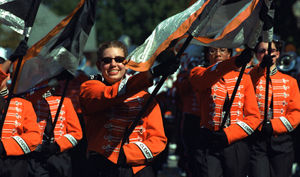 Clemson University's Color guard performs during
Pre-game ceremonies
Clemson University's Color guard performs during
Pre-game ceremonies
Many bands have auxiliaries who add a visual component to the performance. For ceremonial bands, this could be a traditional color guard or honor guard. For show bands and drum corps, this could include dancers, cheerleaders, or some type of drill team. Auxiliaries may be collectively referred to as color guard, though the term correctly refers only to those carrying flags for ceremonial purposes.
Auxiliaries may perform as independent groups. In the early 1970s, color guards began to hold their own competitions in the winter (after the American football season, and before the beginning of the summer drum and bugle corps competitions). There are also numerous cheerleading and dance competitions in the off-season.
The color guard of a marching band or drum and bugle corps may contain sabers, rifles, and tall flags. In modern bands, other props are often used: flags of all sizes, horizontal banners, vertical banners, streamers, pom-poms, even tires and hula hoops. While military color guards were typically male, band color guards tend to be primarily female, though it is becoming more common for males to join as well. Guards most often have a special uniform or costume that is distinctive from that of band, and may or may not match. Colorguard can compete without the band in such competitions as winter guard.
Performance elements
The goal of each band's performance is different. Some bands aim for maximum uniformity and precision. Others – especially scramble bands – want to be as entertaining as possible. Many U.S. university marching bands aim for maximum sound "impact" on the audience. Some bands perform primarily for the enjoyment of their own members. However, there are some common elements in almost all band performances.
Music
The traditional music of the marching band is the military march, but since show bands evolved from the concert and brass band traditions as well, music has always been varied. Often, music from other genres is adapted for the specific instrumentation of a marching band. Commercial arrangements that are tailored for the "average" band instrumentation are also available. Military and university bands typically have a repertoire of "traditional" music associated with the organization they serve. Many competitive bands will choose to use an arrangement of popular music varied for marching band, as well as music from a movie or other such theme.
Music may be memorized, or it may be carried on flip folders that clip onto the instruments, called lyre clips. Having music memorized is usually considered an advantage for competitive bands in addition to preventing obstruction of vision caused by the flip folders. It is also a point of honor in some bands that memorize their music.
March steps
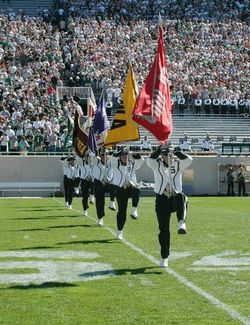 Members of Michigan State University's
Spartan Marching Band demonstrate "chair" highstep
during a pregame show
Members of Michigan State University's
Spartan Marching Band demonstrate "chair" highstep
during a pregame show
Many bands use some variation of the glide step. This step involves bringing the heel gently to the ground with the toe pointed, and then rolling forward onto the toes before lifting the foot. Using a glide step is the easiest way for wind players to avoid bouncing the mouthpiece of their instrument on their lips or in their mouth, thus aiding in the production of a steady tone even when the band is moving.
Along with the roll or glide step, there is also a 'high step.' Many traditional style colleges and universities such as: The Spartan Marching Band, the University of Wisconsin-Madison, Ohio University, the Spirit of Troy, and University of Oklahoma execute this style. In addition, most Historically Black Colleges or Universities (HBCUs) like Prairie View Agricultural and Mechanical University, Texas Southern University, University of Arkansas at Pine Bluff, Florida Agricultural and Mechanical University, Jackson State University, Southern University and Agricultural and Mechanical College, Norfolk State University,Tennessee State University, and Alabama State University still utilize this style of marching. Some secondary schools that have deep tradition in their marching band also high step. While this historical style may slowly be replaced in some programs by "low step" marching, it is still exciting to see this style with a marching band.
Variations of the high step:
- There is one high step where the band member rolls his or her foot out to the toe, bending the knee. The knee then locks, and the leg is lifted out in front of the marcher before it is put down in the new position.
-Another high step involves bringing the foot up to the inside of the leg to the knee before coming down and forward. Some bands may refer to this as "tucking." This is also the style for many HBCU bands.
-An older high step involves the lifting of the knee with legs directly in front, thighs parallel to the ground, and toes pointed downward. When the leg is elevated, it should give the appearance of a 90-degree angle with the thigh and leg, and the body and thigh. The leg is then lowered, and this is repeated with the other leg. This is informally referred to as the "chair." The University of Minnesota marching band uses this style.
Marking Time
When a band is not moving, the members may mark time, or march in place. The step used usually resembles the step that is used for marching forward, though mixing a high step mark time with a roll step march (or vice versa) produces an interesting visual effect. Some bands forgo marking time and instead come to a complete halt when not marching.
When band members are marching in one direction but want to focus their sound in another, they may rotate their bodies at the waist, so that only the upper portion of the body faces in the direction of play. This is known as "shifting" or "sliding." Percussion players, whose large drum harnesses often prevent them from twisting their torsos, and sometimes tuba and sousaphone players, will instead use a crab step when moving sideways. During a crab step, the musician crosses one leg over the other, either marching on the toes or rolling the foot sideways. Percussionists may also substitute roll step when their instruments would interfere with performing the high step.
Backward Marching
A back march may be used when the band wishes to move in the opposite direction from where it is projecting its sound. There are several ways to back march, one of which is to walk backwards, putting each foot down and rolling from the toe to the heel (the exact reverse of the roll step). Another variation involves marching on the toes, dragging the toe of the moving foot on the ground to improve balance. With this method, the heel of the foot never touches the ground. Using peripheral vision to align oneself to formations or field markings is even more important during backward marching.
Even when marking time, it is always considered good form for all band members to stay in step – that is, step with the same foot at the same time. A large majority of bands step off with, or start marching on, the left foot, the Cadets drum and bugle corps being the only exception. Staying in step is generally easier when the band is playing music or when the drums are playing a marching cadence. When the band and percussion are not playing, rhythm may be maintained in a variety of ways: a drummer may play clicks or rim shots, the drum major may clap, a drum major or band member may vocalize a sharp syllable like "hit", "hut", or "dhut" (the last is usually characteristic of the drum line, and often said before playing in the rhythm; dhut,dhut, dhut dhut dhut dhut [one, two, one two three four] ) , or band members may chant the military call of "Left, left, left right left".
Uniforms
Nearly all marching bands use some kind of uniform. Military-style uniforms are most common, but there are bands that use everything from matching T-shirts and shorts to formal wear. Capes, rank cords, and other embellishments are common. Sometimes uniforms have substantially different colors on the front and back, so if band members turn suddenly (flank) the audience will see a striking change of color. Many Ivy League band members wear a jacket and tie while performing. The University of Oregon band wears outfits that are designed to look like their football team's uniforms. Drum Majors often wear more formal outfits or costumes that match the theme of the music.
Common design elements include hats (typically shakos, helmets, or Australian-style brimmed hats) with feather plumes, capes, and the school or organization's name or symbol. Sousaphone players traditionally wear a military-style beret, as other hats may be in the way of the bell. It is also common for band uniforms to have a stripe down the leg and light-colored shoes (or spats over dark shoes) to emphasize the movement of the legs while marching. However, competitive bands may opt for dark pants and shoes to hide members who are out of step. Some bands include dark colored socks as a piece of the uniform, and members who forget, and wear white socks, will attach black electrical tape over the offending socks. This is considered a mark of shame or of inexperience among other marchers.
Some auxiliary groups use uniforms that resemble gymnastics or cheerleading outfits.
Occasionally, a band will forgo traditional uniforms in favor of costumes that fit the theme of its field show. The costumes may or may not be uniform throughout the band. This kind of specialized uniform change is usually confined to competitive marching bands.
Parade marching
For parades, the band lines up in a marching block composed of ranks (rows) and files (columns). Typically, each member tries to stay within his or her given rank and file, and to maintain even spacing with neighboring musicians. It is usually the responsibility of the people at the end of each rank and the front of each file to be in the correct location; this allows other band members to guide to them.
Band members also try to keep a constant pace or step size while marching in parade. This usually varies between 22 and 30 inches (56–76 cm) per stride. A step size of 22.5 inches is called 8-to-5 because the marcher covers five yards (about 4.6 m) in eight steps. A step size of 30 inches is called 6-to-5 because five yards are covered in six steps. Because yard lines on an American football field are five yards apart, exact 8-to-5 and 6-to-5 steps are most useful for field shows.
A drum cadence (sometimes called a walkbeat or street beat) is usually played when the band is marching, sometimes alternating with a song. This is how the band keeps time. Alternately, a drum click or rim shot may be given on the odd beats to keep the band in step. Between songs and cadences, a roll is usually given to indicate what beat in the measure the band is at. Cadence tempo varies from group to group, but is generally between 112 and 144 beats per minute.
Video: Watch the Michigan State University Spartan Marching Band's "March to the Stadium"
Field marching
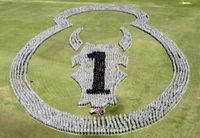 A
Brigade combat team forming a logo on a field during a
farewell ceremony
A
Brigade combat team forming a logo on a field during a
farewell ceremony
While playing music during a field show, the band makes a series of formations on the field, which may be pictures, geometric shapes, curvilinear designs, or blocks of players. These maneuvers are collectively called drill. Typically, each band member has an assigned position in each formation. There are as many ways of getting from one formation to the next as there are bands:
- each member can move independently – this is called scattering
- all the members can move together without deforming the picture – this is called floating
- the members can stay in their lines and arcs, but slowly deform the picture
- the members can break into ranks or squads, each of which performs a maneuver (such as a follow-the-leader) which may or may not be scripted – an unscripted move is sometimes called a rank option
- each member may have a specifically scripted move to perform – in these cases, the desired visual effect is often the move itself and not the ending formation
Many bands use a combination of the above techniques, sometimes adding dance choreography that is done in place or while marching. Players may point the bells of their instruments in the direction they are moving, or slide (also called traverse) with all the bells facing in the same direction. Bands that march in time with the music typically also synchronize the direction of individuals' turns, and try to maintain even spacing between individuals in formations. Sometimes bands will specifically have wind players turn their instruments away from the audience in order to emphasize the dynamics of the music.
Auxiliaries can also add to the visual effect. Backdrops and props may be used on the field that fit the theme of the show or the music being performed. In comedic shows, an announcer may read jokes or a funny script between songs; formations that are words or pictures (or the songs themselves) may serve as punch lines.
Phasing
In addition to staying in step and marching uniformly, one of the challenges with playing in large outdoor arenas is phasing. This is when part of the band gets behind or ahead of another part of the band, and such an occurrence is sometimes called an ensemble tear.
Phasing may be a subjective effect, due to the finite speed of sound. Even if all members of a band are playing at once, the sound from their instruments may reach listeners at different times. For example, if two musicians, one standing on the front sideline of the football field and one on the back sideline, begin playing exactly when they see the beat of the conductor's baton, the sound produced by the musician on the front sideline will reach listeners in the stand before the sound played by the back musician. This is because the speed of sound is significantly slower than the speed of light. Sound may also echo off parts of the stadium or nearby buildings.
Phasing can be reduced in several ways, including:
- keeping formations compact
- having players listen to the drums in addition to watching the drum major, to get a uniform idea of tempo (this only works if the drill is not spread across the entire field)
- having musicians make constant adjustments and keep watching or listening to sources of tempo so as to try and make their sound reach the audience at the same time as other musicians
- having players located near the back of the field watch the drum major, and all other players "listen back", playing along with those watching the drum major.
Rehearsals
Some bands will perform the same field show at all of their appearances during a single season. Others will avoid repeating a performance in front of the same crowd. In either case, the amount of rehearsal required varies greatly depending on the number and complexity of the formations, and the difficulty of the music. Some bands do a new field show every week, but only practice drill for two or three hours immediately before the performance. Other bands can practice a single show upwards of 20 hours per week (or more, for some competitive drum and bugle corps) for an entire season.
Music for parade and show bands is typically learned separately, in a concert band setting. It may even be memorized before any of the marching steps are learned. When rehearsing drill, positions and maneuvers are usually learned without playing the music simultaneously – a common technique for learning drill is to have members sing their parts or march to a recording produced during a music rehearsal. Many bands learn drill one picture or form at a time, and later combine these and add music. Rehearsals may also include physical warm-up (stretching, jumping jacks, etc.), music warm-up (generally consisting of breathing exercises, scales, technical exercises, chorales, and tuning), basics (simple marching in a block to practice proper technique), and sectionals (in which either staff or band members designated section leaders rehearse individual sections).
When learning positions for drill, an American football field may be divided into a 5-yard grid, with the yard lines serving as one set of guides. The locations where the perpendicular grid lines cross the yard lines, sometimes called zero points, may be marked on a practice field. Alternately, band members may only use field markings – yard lines, the center line, hash marks, and yard numbers – as guides (but note that different leagues put these markings in different places). In order for members to learn their positions more quickly, they may be given drill charts, which map their locations relative to the grid or field markings for each formation. In other groups, spray chalk is used to mark the location of each person after each set of drill, with a different color and shape for each move.
Members may also group into squads, ranks, sections, or (especially with scramble bands that primarily form words) letters. Instead of each member having an individual move, moves are then learned on a squad-by-squad (rank-by-rank, etc.) basis.
March steps and traditional music and drill that are unique to an organization are often taught at a band camp, a time set aside for intense rehearsal before the performance season begins. Many U.S. university bands meet for a week of band camp prior to the beginning of the autumn semester. Other band camps exist for individual band members, drum majors, and auxiliaries to practice their skills and learn generic techniques in the off-season. For many bands, band camp is actually camp: the groups board at a campground for a period of time. Other groups simply hold band camp at their typical rehearsal facilities. Many bands have an innitiation night that helps build a greater bond between the musicians.
Competitions
In competitions, bands are usually judged on criteria such as musicality, uniformity, visual impact, artistic interpretation, and the difficulty of the music and drill. Competition exists at all levels, but is most common in the U.S. among secondary school bands and drum and bugle corps. Performances designed for a competition setting usually include more esoteric music (including but not limited to adaptations of modern orchestral pieces).
National and Regional Competitions
In the United States, Bands of America holds the Grand National Championships for high school marching bands every November in the RCA Dome in Indianapolis. They also hold regional championships throughout the United States each fall. Bands are divided into three classes based on school size.
Bands in most competitions are classified by the number of wind players. Bands can ask or "petition" up a class to challenge themselves but may not move down. An example classification used in some U.S. competitions is as follows:
- A – Up to 36 wind players
- AA – 37–54 wind players
- AAA – 55–77 wind players
- AAAA – 78–100 wind players
- Open – 101 or more wind players
Local Competitions
In addition to the Bands of America competitions, many states also hold local championships for high school marching band. In this case, school size is the determining factor in which class bands compete in, rather than the amount of wind players. Examples of these local circuits include:
- New York State Field Band Conference
Musical Arts Conference
Eastern Marching Band Association
Southern California School Band and Orchestra Association - Tournament of Bands
- United States Scholastic Band Association
The Sudler Trophy
The Sudler Trophy is an award bestowed by the John Philip Sousa Foundation on one university marching band each year. No school may win the award twice. The official description of the trophy is:
The purpose of the Sudler Trophy is to identify and recognize collegiate marching bands of particular excellence who have made outstanding contributions to the American way of life. The Sudler Trophy is awarded annually to a college or university marching band which has demonstrated the highest musical standards and innovative marching routines and ideas, and which has made important contributions to the advancement of the performance standards of college marching bands over a period of years.
The following are the recipients of the Sudler Trophy since its inception in 1982:
1982 University of Michigan
1983 University of Illinois at Urbana-Champaign
1984 The Ohio State University
1985 Florida A&M University
1986 University of Texas at Austin
1987 University of Oklahoma
1988 Michigan State University
1989 University of Kansas
1990 University of Iowa
1991 Arizona State University
1992 Northwestern University
1993 University of California, Los Angeles (UCLA)
1994 James Madison University
1995 Purdue University
1996 University of Nebraska-Lincoln
1997 West Virginia University
1998 University of Massachusetts Amherst
1999 Texas Tech University
2000 University of Georgia
2001 Texas A&M University
2002 Louisiana State University
2003 University of Alabama
2004 Auburn University
2005 Pennsylvania State University
2006 University of Arkansas
See also
- Military band
- Brass band
- Scramble band
- Marching Percussion
- Drum and bugle corps (classic)
- Drum and bugle corps (modern), governed by Drum Corps International Drum Corps Associates, and Drum Corps Midwest
- Martial music
References
External links
- MarchingWiki.com
- The Carnival Band
- John Philip Sousa Foundation
- Marching.com
- MarchingArts.com
- Marching Bands Online
- Marching Band in Texas
- WorldOfPageantry.com
- Drum Corps International (DCI)
- Carnival Band Secretaries League (CBSL)
- Compendium of College Marching Bands
Categories: Musical groups




 216.73.216.190
216.73.216.190 User Stats:
User Stats:
 Today: 0
Today: 0 Yesterday: 0
Yesterday: 0 This Month: 0
This Month: 0 This Year: 0
This Year: 0 Total Users: 117
Total Users: 117 New Members:
New Members:
 216.73.xxx.xxx
216.73.xxx.xxx
 Server Time:
Server Time: